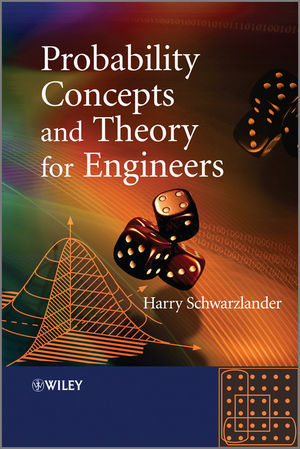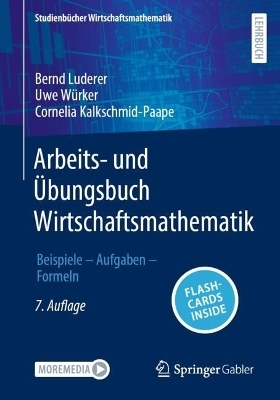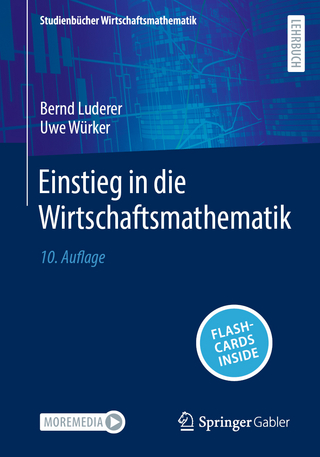
Probability Concepts and Theory for Engineers
John Wiley & Sons Inc (Verlag)
978-0-470-74855-8 (ISBN)
- Titel z.Zt. nicht lieferbar
- Versandkostenfrei innerhalb Deutschlands
- Auch auf Rechnung
- Verfügbarkeit in der Filiale vor Ort prüfen
- Artikel merken
A thorough introduction to the fundamentals of probability theory
This book offers a detailed explanation of the basic models and mathematical principles used in applying probability theory to practical problems. It gives the reader a solid foundation for formulating and solving many kinds of probability problems for deriving additional results that may be needed in order to address more challenging questions, as well as for proceeding with the study of a wide variety of more advanced topics.
Great care is devoted to a clear and detailed development of the ‘conceptual model' which serves as the bridge between any real-world situation and its analysis by means of the mathematics of probability. Throughout the book, this conceptual model is not lost sight of. Random variables in one and several dimensions are treated in detail, including singular random variables, transformations, characteristic functions, and sequences. Also included are special topics not covered in many probability texts, such as fuzziness, entropy, spherically symmetric random variables, and copulas.
Some special features of the book are:
a unique step-by-step presentation organized into 86 topical Sections, which are grouped into six Parts
over 200 diagrams augment and illustrate the text, which help speed the reader's comprehension of the material
short answer review questions following each Section, with an answer table provided, strengthen the reader's detailed grasp of the material contained in the Section
problems associated with each Section provide practice in applying the principles discussed, and in some cases extend the scope of that material
an online separate solutions manual is available for course tutors.
The various features of this textbook make it possible for engineering students to become well versed in the ‘machinery' of probability theory. They also make the book a useful resource for self-study by practicing engineers and researchers who need a more thorough grasp of particular topics.
Professor Harry Schwarzlander, Department of Electrical Engineering and Computer Science, Syracuse University, Syracuse, New York, USA Harry Schwarzlander is Associate Professor Emeritus at Syracuse University and has been with the university since 1964 where he has developed and taught 25 courses to electrical engineering graduate and undergraduate students. He was an Instructor in the Department of Electrical Engineering at Purdue University from 1960 to 1964, and before that, an Engineer and Project Engineer for General Electronic Laboratories, Inc., Cambridge, Massachusetts. Professor Schwarzlander is a Registered Professional Engineer in New York and a Life Member of IEEE, taking posts as Secretary and Chairman between 1967 and 1969. In 2004 he was awarded Doctor Honoris Causa 'in recognition of outstanding accomplishments, exemplary educational leadership and distinguished service to mankind' by The International Institute for Advanced Studies in Systems Research and Cybernetics. He holds one patent for the RMS-Measuring Voltmeter, 1959. Currently Executive Director of The New Environment, Inc. and Editor of New Environment Bulletin (the monthly newsletter of the New Environment Association), Professor Schwarzlander has contributed to over 65 publications and presentations. He researches into a range of different areas, including interference testing of electronic equipment and information storage and retrieval.
Preface xi
Introduction xiii
Part I The Basic Model
Part I Introduction 2
Section 1 Dealing with ‘Real-World’ Problems 3
Section 2 The Probabilistic Experiment 6
Section 3 Outcome 11
Section 4 Events 14
Section 5 The Connection to the Mathematical World 17
Section 6 Elements and Sets 20
Section 7 Classes of Sets 23
Section 8 Elementary Set Operations 26
Section 9 Additional Set Operations 30
Section 10 Functions 33
Section 11 The Size of a Set 36
Section 12 Multiple and Infinite Set Operations 40
Section 13 More About Additive Classes 44
Section 14 Additive Set Functions 49
Section 15 More about Probabilistic Experiments 53
Section 16 The Probability Function 58
Section 17 Probability Space 62
Section 18 Simple Probability Arithmetic 65
Part I Summary 71
Part II The Approach to Elementary Probability Problems
Part II Introduction 74
Section 19 About Probability Problems 75
Section 20 Equally Likely Possible Outcomes 81
Section 21 Conditional Probability 86
Section 22 Conditional Probability Distributions 91
Section 23 Independent Events 99
Section 24 Classes of Independent Events 104
Section 25 Possible Outcomes Represented as Ordered k-Tuples 109
Section 26 Product Experiments and Product Spaces 114
Section 27 Product Probability Spaces 120
Section 28 Dependence Between the Components in an Ordered k-Tuple 125
Section 29 Multiple Observations Without Regard to Order 128
Section 30 Unordered Sampling with Replacement 132
Section 31 More Complicated Discrete Probability Problems 135
Section 32 Uncertainty and Randomness 140
Section 33 Fuzziness 146
Part II Summary 152
Part III Introduction to Random Variables
Part III Introduction 154
Section 34 Numerical-Valued Outcomes 155
Section 35 The Binomial Distribution 161
Section 36 The Real Numbers 165
Section 37 General Definition of a Random Variable 169
Section 38 The Cumulative Distribution Function 173
Section 39 The Probability Density Function 180
Section 40 The Gaussian Distribution 186
Section 41 Two Discrete Random Variables 191
Section 42 Two Arbitrary Random Variables 197
Section 43 Two-Dimensional Distribution Functions 202
Section 44 Two-Dimensional Density Functions 208
Section 45 Two Statistically Independent Random Variables 216
Section 46 Two Statistically Independent Random Variables—Absolutely Continuous Case 221
Part III Summary 226
Part IV Transformations and Multiple Random Variables
Part IV Introduction 228
Section 47 Transformation of a Random Variable 229
a) Transformation of a discrete random variable 229
b) Transformation of an arbitrary random variable 231
c) Transformation of an absolutely continuous random variable 235
Section 48 Transformation of a Two-Dimensional Random Variable 238
Section 49 The Sum of Two Discrete Random Variables 243
Section 50 The Sum of Two Arbitrary Random Variables 247
Section 51 n-Dimensional Random Variables 253
Section 52 Absolutely Continuous n-Dimensional R.V.’s 259
Section 53 Coordinate Transformations 263
Section 54 Rotations and the Bivariate Gaussian Distribution 268
Section 55 Several Statistically Independent Random Variables 274
Section 56 Singular Distributions in One Dimension 279
Section 57 Conditional Induced Distribution, Given an Event 284
Section 58 Resolving a Distribution into Components of Pure Type 290
Section 59 Conditional Distribution Given the Value of a Random Variable 293
Section 60 Random Occurrences in Time 298
Part IV Summary 304
Part V Parameters for Describing Random Variables and Induced Distributions
Part V Introduction 306
Section 61 Some Properties of a Random Variable 307
Section 62 Higher Moments 314
Section 63 Expectation of a Function of a Random Variable 320
a) Scale change and shift of origin 320
b) General formulation 320
c) Sum of random variables 322
d) Powers of a random variable 323
e) Product of random variables 325
Section 64 The Variance of a Function of a Random Variable 328
Section 65 Bounds on the Induced Distribution 332
Section 66 Test Sampling 336
a) A Simple random sample 336
b) Unbiased estimators 338
c) Variance of the sample average 339
d) Estimating the population variance 341
e) Sampling with replacement 342
Section 67 Conditional Expectation with Respect to an Event 345
Section 68 Covariance and Correlation Coefficient 350
Section 69 The Correlation Coefficient as Parameter in a Joint Distribution 356
Section 70 More General Kinds of Dependence Between Random Variables 362
Section 71 The Covariance Matrix 367
Section 72 Random Variables as the Elements of a Vector Space 374
Section 73 Estimation 379
a) The concept of estimating a random variable 379
b) Optimum constant estimates 379
c) Mean-square estimation using random variables 381
d) Linear mean-square estimation 382
Section 74 The Stieltjes Integral 386
Part V Summary 393
Part VI Further Topics in Random Variables
Part VI Introduction 396
Section 75 Complex Random Variables 397
Section 76 The Characteristic Function 402
Section 77 Characteristic Function of a Transformed Random Variable 408
Section 78 Characteristic Function of a Multidimensional Random Variable 412
Section 79 The Generating Function 417
Section 80 Several Jointly Gaussian Random Variables 422
Section 81 Spherically Symmetric Vector Random Variables 428
Section 82 Entropy Associated with Random Variables 435
a) Discrete random variables 435
b) Absolutely continuous random variables 438
Section 83 Copulas 443
Section 84 Sequences of Random Variables 454
a) Preliminaries 454
b) Simple gambling schemes 455
c) Operations on sequences 458
Section 85 Convergent Sequences and Laws of Large Numbers 461
a) Convergence of sequences 461
b) Laws of large numbers 464
c) Connection with statistical regularity 468
Section 86 Convergence of Probability Distributions and the Central Limit Theorem 470
Part VI Summary 477
Appendices 479
Answers to Queries 479
Table of the Gaussian Integral 482
Part I Problems 483
Part II Problems 500
Part III Problems 521
Part IV Problems 537
Part V Problems 556
Part VI Problems 574
Notation and Abbreviations 587
References 595
Subject Index 597
| Erscheint lt. Verlag | 21.2.2011 |
|---|---|
| Verlagsort | New York |
| Sprache | englisch |
| Maße | 175 x 251 mm |
| Gewicht | 1166 g |
| Themenwelt | Mathematik / Informatik ► Mathematik ► Angewandte Mathematik |
| Mathematik / Informatik ► Mathematik ► Wahrscheinlichkeit / Kombinatorik | |
| Technik ► Elektrotechnik / Energietechnik | |
| ISBN-10 | 0-470-74855-9 / 0470748559 |
| ISBN-13 | 978-0-470-74855-8 / 9780470748558 |
| Zustand | Neuware |
| Haben Sie eine Frage zum Produkt? |
aus dem Bereich


